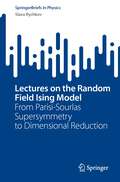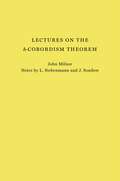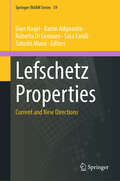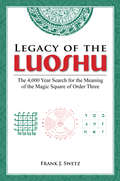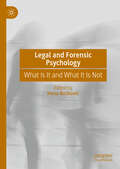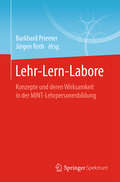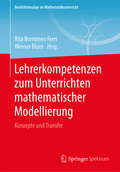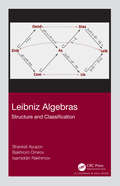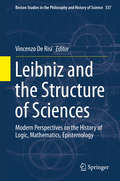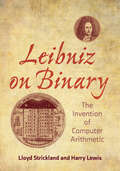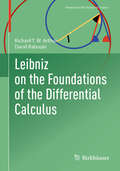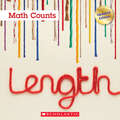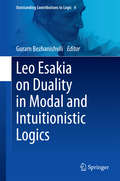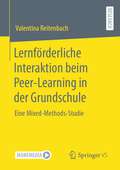- Table View
- List View
Lectures on the Random Field Ising Model: From Parisi-Sourlas Supersymmetry to Dimensional Reduction (SpringerBriefs in Physics)
by Slava RychkovThis book is about the Random Field Ising Model (RFIM) – a paradigmatic spin model featuring a frozen disordering field. The focus is on the second-order phase transition between the paramagnetic and ferromagnetic phases, and the associated critical exponents. The book starts by summarizing the current knowledge about the RFIM from experiments, numerical simulations and rigorous mathematical results. It then reviews the classic theoretical works from the 1970’s which suggested a property of dimensional reduction – that the RFIM critical exponents should be the same as for the ordinary, non-disordered, Ising model of lower dimensionality, and related this an emergent Parisi-Sourlas supersymmetry. As is now known, these remarkable properties only hold when the spatial dimensionality of the model is larger than a critical dimension. The book presents a method to estimate the critical dimension, using standard tools such as the replica trick and perturbative renormalization group, whose result is in agreement with the numerical simulations. Some more elementary steps in the derivations are left as exercises for the readers. This book is of interest to researchers, PhD students and advanced master students specializing in statistical field theory.
Lectures on the h-Cobordism Theorem
by John MilnorImportant lectures on differential topology by acclaimed mathematician John MilnorThese are notes from lectures that John Milnor delivered as a seminar on differential topology in 1963 at Princeton University. These lectures give a new proof of the h-cobordism theorem that is different from the original proof presented by Stephen Smale. Milnor's goal was to provide a fully rigorous proof in terms of Morse functions. This book remains an important resource in the application of Morse theory.
Lee de Forest
by Mike AdamsThe life-long inventor, Lee de Forest invented the three-element vacuum tube used between 1906 and 1916 as a detector, amplifier, and oscillator of radio waves. Beginning in 1918 he began to develop a light valve, a device for writing and reading sound using light patterns. While he received many patents for his process, he was initially ignored by the film industry. In order to promote and demonstrate his process he made several hundred sound short films, he rented space for their showing; he sold the tickets and did the publicity to gain audiences for his invention. Lee de Forest officially brought sound to film in 1919. Lee De Forest: King of Radio, Television, and Film is about both invention and early film making; de Forest as the scientist and producer, director, and writer of the content. This book tells the story of de Forest's contribution in changing the history of film through the incorporation of sound. The text includes primary source historical material, U.S. patents and richly-illustrated photos of Lee de Forest's experiments. Readers will greatly benefit from an understanding of the transition from silent to audio motion pictures, the impact this had on the scientific community and the popular culture, as well as the economics of the entertainment industry.
Lefschetz Properties: Current and New Directions (Springer INdAM Series #59)
by Karim Adiprasito Uwe Nagel Roberta Di Gennaro Sara Faridi Satoshi MuraiThe study of Lefschetz properties for Artinian algebras was motivated by the Lefschetz theory for projective manifolds. Recent developments have demonstrated important cases of the Lefschetz property beyond the original geometric settings, such as Coxeter groups or matroids. Furthermore, there are connections to other branches of mathematics, for example, commutative algebra, algebraic topology, and combinatorics. Important results in this area have been obtained by finding unexpected connections between apparently different topics. A conference in Cortona, Italy in September 2022 brought together researchers discussing recent developments and working on new problems related to the Lefschetz properties. The book will feature surveys on several aspects of the theory as well as articles on new results and open problems.
Left to Their Own Devices: How Digital Natives Are Reshaping the American Dream
by Julie M. AlbrightA sociologist explores the many ways that digital natives' interaction with technology has changed their relationship with people, places, jobs, and other stabilizing structures and created a new way of life that is at odds with the American Dream of past generations. Digital natives are hacking the American Dream. Young people brought up with the Internet, smartphones, and social media are quickly rendering old habits, values, behaviors, and norms a distant memory--creating the greatest generation gap in history. In this eye-opening book, digital sociologist Julie M. Albright looks at the many ways in which younger people, facilitated by technology, are coming "untethered" from traditional aspirations and ideals, and asks: What are the effects of being disconnected from traditional, stabilizing social structures like churches, marriage, political parties, and long-term employment? What does it mean to be human when one's ties to people, places, jobs, and societal institutions are weakened or broken, displaced by digital hyper-connectivity? Albright sees both positives and negatives. On the one hand, mobile connectivity has given digital nomads the unprecedented opportunity to work or live anywhere. But, new threats to well-being are emerging, including increased isolation, anxiety, and loneliness, decreased physical exercise, ephemeral relationships, fragmented attention spans, and detachment from the calm of nature. In this time of rapid, global, technologically driven change, this book offers fresh insights into the unintended societal and psychological implications of lives exclusively lived in a digital world.
Legacy of the Luoshu: The 4,000 Year Search for the Meaning of the Magic Square of Order Three
by Frank SwetzA symbol of the Divine, a good luck charm, a cosmogram of the world order, a template for fengshui-through the ages, the luoshu, or magic squre of order three, has fascinated people of many different cultures. In this riveting account of cultural detective work, renowned mathematics educator, Frank J. Swetz relates how he uncovered the previously h
Legal and Forensic Psychology: What Is It and What It Is Not
by Irena BoškovićThis book seeks to distinguish empirically-based knowledge from widespread misconceptions in the fields of legal and forensic psychology. Across ten chapters, leading scholars contribute different perspectives on their areas of expertise within the fields of legal and forensic psychology, providing a comprehensive overview of the historical context and defining characteristics of these two disciplines. The first section of the book is dedicated to legal psychology, exploring issues such as pseudoscience in lie detection, the use of polygraphs, and the reliability of eyewitness testimony and memory reports in legal settings. The second focuses on forensic psychology, addressing topics such as the relationship between criminal behavior and psychopathology, symptom validity assessment, risk assessment, and the treatment of forensic patients. As such, this vital book will serve as an excellent starting point for those seeking to educate themselves about these disciplines.
LegalTech and Legal-AI in Business: Major and Promising Sectors of Economy (Intelligent Systems Reference Library #276)
by Agnessa Inshakova Denis Matytsin Iolanta BaltutiteThis book offers an interdisciplinary scientific study and ecosystem description of organizational and institutional mechanisms for the introduction of artificial intelligence technologies, digital technologies and robotic systems in the legal support of business processes, the development of regulatory mechanisms to protect the rights of business entities in the digital economy, and the formation of the sixth technological mode. This book includes the study of legal support of the main and promising areas of business, in the regulation of which robotics, digital technologies, and artificial intelligence are actively used to increase efficiency, protect the rights of participants, minimize business risks, improve quality, and stimulate innovation in companies and high-tech production. This book provides applied recommendations for preventing and managing business risks in the context of the application of artificial intelligence and robotics in law.
Legalized Inequalities: Immigration and Race in the Low-wage Workplace
by Shannon Gleeson Kati L. Griffith Patricia Campos-Medina Dubuisson DarleneBeyond unlivable wages and a lack of upward mobility, low-wage work in the United States is rife with danger and degrading treatment. Immigrants and people of color are overrepresented in these “bad jobs” and often feel as though they are unable to change their working conditions. In Legalized Inequalities, law scholar Kati L. Griffith, sociologist Shannon Gleeson, anthropologist Darlène Dubuisson, and political scientist Patricia Campos-Medina investigate the government’s role in perpetuating poor and dangerous work environments for low-wage immigrant workers of color. Drawing on interviews with over three hundred low-wage Haitian and Central American workers and worker advocates, Griffith, Gleeson, Dubuisson, and Campos-Medina reveal how U.S. policies produce and sustain job instability and insecurity. Together, contemporary U.S. labor and employment law, immigration policy, and enduring racial inequality work in tandem to keep workers’ wages low, lock them into substandard working conditions, and minimize opportunities to push for change. Workplace regulations meant to protect workers are weak and underenforced, privileging employers over workers. At-will employment policies, which allow employers to terminate employees without cause, discourage workers from bargaining for better jobs or holding employers accountable for even the most egregious mistreatment. Federal immigration policy further disempowers workers by deputizing employers to act as immigration enforcement agents through immigration status verification requirements. Undocumented workers often believe they must endure maltreatment or risk deportation. Anti-immigrant sentiment—encouraged by U.S. policy—impacts workers across all status groups. Additionally, despite a proliferation of civil rights legislation, racial disparities remain in the workplace. Workers of color are often paid less, forced to complete more dangerous and demeaning tasks, and subjected to racial harassment. While these workers face formidable barriers to fighting for their rights, they are not entirely powerless. Some low-wage workers filed formal complaints with government agencies. Others, on their own or collectively, confronted their employers to demand fair and dignified treatment. Some even quit in protest of their poor working conditions. The authors argue that reforming labor and employment law, immigration law, and Civil Rights law is necessary to reshape the low-wage workplace. They suggest increasing funding for workers’ rights enforcement agencies, removing the mandate for employers to verify a worker’s immigration status, and making it easier to prove that employment discrimination has occurred, among other policy proposals, to help empower and protect low-wage immigrant workers of color. Legalized Inequalities not only highlights the crushing consequences of U.S. policy on low-wage immigrant workers of color but showcases their resilience in the face of these obstacles.
Lehr-Lern-Labore: Konzepte und deren Wirksamkeit in der MINT-Lehrpersonenbildung
by Jürgen Roth Burkhard PriemerAn verschiedenen Hochschulen werden in den MINT-Fächern Schülerlabore in die Lehrpersonenbildung integriert. In diesen - als Lehr-Lern-Labore bezeichneten - Einrichtungen werden MINT-Lernumgebungen für Schülerinnen und Schüler, Veranstaltungen der Lehrpersonenbildung und an vielen Standorten auch fachdidaktische Forschung fruchtbar miteinander verknüpft. Das Ziel ist dabei, evidenzbasiert innovative Lehrkonzepte für Schule und Hochschule zu entwickeln und zu implementieren. In diesem Band werden Lehr-Lern-Labore zunächst allgemein beschrieben und dann durch zahlreiche Beispiele von Konzepten verschiedener Hochschulstandorte illustriert. Darüber hinaus wird berichtet, welche Wirksamkeit Lehr-Lern-Labore bei der Förderung von Kompetenzen zukünftiger Lehrpersonen haben und wie Studierende diese Einrichtungen wahrnehmen. Die vorgestellten Forschungsergebnisse, die aus einem Verbund von sechs Hochschulen stammen, sollen durch diesen Band weiteren Standorten zugänglich gemacht werden. Dieses Buch richtet sich an Studierende und Dozierende der Lehrpersonenbildung in Hochschulen - insbesondere in den MINT-Fachdidaktiken - sowie an Personen in Schule und Referendariat.
Lehrerkompetenzen zum Unterrichten mathematischer Modellierung: Konzepte und Transfer (Realitätsbezüge im Mathematikunterricht)
by Werner Blum Rita Borromeo FerriIm vorliegenden Band wird verdeutlicht, welche Kompetenzen Lehrkräfte haben sollten, um Schülerinnen und Schülern im Unterricht mathematisches Modellieren zu vermitteln. Im ersten Teil des Buches liegt der Fokus auf den zum Unterrichten von Modellierung in der Schule nötigen Lehrerkompetenzen. Dabei werden auch Möglichkeiten zur Förderung solcher Kompetenzen aufgezeigt. Im zweiten Teil des Buches stehen Konzepte für die Lehreraus- und -fortbildung im Vordergrund, die angehenden und praktizierenden Lehrkräften jene Kompetenzen vermitteln können. Lehrende in Schule und Hochschule wie auch Studierende des Lehramts finden in diesem Buch zahlreiche Anregungen aus Forschung und Praxis zu Lehrerkompetenzen in Bezug auf Modellieren und zu deren Erwerb.
Lehrinnovationen in der Hochschulmathematik: praxisrelevant – didaktisch fundiert – forschungsbasiert (Konzepte und Studien zur Hochschuldidaktik und Lehrerbildung Mathematik)
by Andreas Eichler Reinhard Hochmuth Niclas Schaper Rolf Biehler Stefanie RachDieses Buch stellt praxisnahe Innovationen für Lehrveranstaltungen zur Mathematik an Hochschulen vor und richtet sich sowohl an Mathematiklehrende wie auch an Forschende in der Hochschuldidaktik Mathematik. Die Innovationen umfassen hierbei einen weiten Bereich mathematischer Lehrveranstaltungen in verschiedenen Studiengängen – von Wirtschaftswissenschaften über Ingenieurwissenschaften bis zum Lehramts- und Fachmathematikstudium. Die Lehrinnovationen wurden im Kompetenzzentrum Hochschuldidaktik Mathematik (khdm), einer gemeinsamen Einrichtung der Universitäten Hannover, Kassel und Paderborn, auf wissenschaftlicher Grundlage konzipiert, in Veranstaltungen erprobt, evaluiert und weiterentwickelt.Im ersten Teil des Bandes stehen fachlich-fachdidaktische Analysen im Vordergrund, die Grundlagen für eine Vermittlung verschiedener Fachthemen wie z. B. Folgenkonvergenz und Signaltheorie bilden. Im Teil „Schnittstellenaktivitäten“ werden erprobte Konzepte dazu vorgestellt, wie im Lehramts- und Ingenieurstudium auch in den mathematischen Fachvorlesungen Verbindungen zur Fachdidaktik bzw. Ingenieurwissenschaft hergestellt werden können. Zusätzlich wird gezeigt, dass geeignete Aufgaben die Motivation der Studierenden verbessern und die verschiedenen Studienstränge besser verknüpfen. Ein Schwerpunkt des dritten Teiles „Mathematikvorkurse“ liegt auf der Integration digitaler Angebote (Einbindung von interaktiven Apps, Lernvideos, digitales Assessment mit STACK). Im vierten Teil des Bandes geht es um die Förderung mathematikspezifischer Arbeitsweisen und insbesondere um Vorschläge zur Neugestaltung von Vorlesungen und Übungsgruppen, die auf eine stärkere kognitive Aktivierung und erfolgreichere Lernprozesse der Studierenden zielen. Außerdem stehen Veranstaltungen im Fokus, die neben der Vermittlung fachlicher Inhalte auch die Vermittlung mathematischer Arbeitsweisen explizit ins Zentrum rücken, z. B. das selbstregulierte Nacharbeiten von Vorlesungen oder das selbstständige Beweisen.
Leibniz Algebras: Structure and Classification
by Shavkat Ayupov Bakhrom Omirov Isamiddin RakhimovLeibniz Algebras: Structure and Classification is designed to introduce the reader to the theory of Leibniz algebras. Leibniz algebra is the generalization of Lie algebras. These algebras preserve a unique property of Lie algebras that the right multiplication operators are derivations. They first appeared in papers of A.M Blokh in the 1960s, under the name D-algebras, emphasizing their close relationship with derivations. The theory of D-algebras did not get as thorough an examination as it deserved immediately after its introduction. Later, the same algebras were introduced in 1993 by Jean-Louis Loday , who called them Leibniz algebras due to the identity they satisfy. The main motivation for the introduction of Leibniz algebras was to study the periodicity phenomena in algebraic K-theory. Nowadays, the theory of Leibniz algebras is one of the more actively developing areas of modern algebra. Along with (co)homological, structural and classification results on Leibniz algebras, some papers with various applications of the Leibniz algebras also appear now. However, the focus of this book is mainly on the classification problems of Leibniz algebras. Particularly, the authors propose a method of classification of a subclass of Leibniz algebras based on algebraic invariants. The method is applicable in the Lie algebras case as well. Features: Provides a systematic exposition of the theory of Leibniz algebras and recent results on Leibniz algebras Suitable for final year bachelor's students, master's students and PhD students going into research in the structural theory of finite-dimensional algebras, particularly, Lie and Leibniz algebras Covers important and more general parts of the structural theory of Leibniz algebras that are not addressed in other texts
Leibniz and the Structure of Sciences: Modern Perspectives on the History of Logic, Mathematics, Epistemology (Boston Studies in the Philosophy and History of Science #337)
by Vincenzo De RisiThe book offers a collection of essays on various aspects of Leibniz’s scientific thought, written by historians of science and world-leading experts on Leibniz. The essays deal with a vast array of topics on the exact sciences: Leibniz’s logic, mereology, the notion of infinity and cardinality, the foundations of geometry, the theory of curves and differential geometry, and finally dynamics and general epistemology. Several chapters attempt a reading of Leibniz’s scientific works through modern mathematical tools, and compare Leibniz’s results in these fields with 19th- and 20th-Century conceptions of them. All of them have special care in framing Leibniz’s work in historical context, and sometimes offer wider historical perspectives that go much beyond Leibniz’s researches. A special emphasis is given to effective mathematical practice rather than purely epistemological thought. The book is addressed to all scholars of the exact sciences who have an interest in historical research and Leibniz in particular, and may be useful to historians of mathematics, physics, and epistemology, mathematicians with historical interests, and philosophers of science at large.
Leibniz in His World: The Making of a Savant
by Audrey BorowskiA sweeping intellectual biography that restores the Enlightenment polymath to the intellectual, scientific, and courtly worlds that shaped his early life and thoughtDescribed by Voltaire as &“perhaps a man of the most universal learning in Europe,&” Gottfried Wilhelm Leibniz (1646–1716) is often portrayed as a rationalist and philosopher who was wholly detached from the worldly concerns of his fellow men. Leibniz in His World provides a groundbreaking reassessment of Leibniz, telling the story of his trials and tribulations as an aspiring scientist and courtier navigating the learned and courtly circles of early modern Europe and the Republic of Letters.Drawing on extensive correspondence by Leibniz and many leading figures of the age, Audrey Borowski paints a nuanced portrait of Leibniz in the 1670s, during his &“Paris sojourn&” as a young diplomat and in Germany at the court of Duke Johann Friedrich of Hanover. She challenges the image of Leibniz as an isolated genius, revealing instead a man of multiple identities whose thought was shaped by a deep engagement with the social and intellectual milieus of his time. Borowski shows us Leibniz as he was known to his contemporaries, enabling us to rediscover him as an enigmatic young man who was complex and all too human.An exhilarating work of scholarship, Leibniz in His World demonstrates how this uncommon intellect, torn between his ideals and the necessity to work for absolutist states, struggled to make a name for himself during his formative years.
Leibniz on Binary: The Invention of Computer Arithmetic
by Lloyd Strickland Harry R. LewisThe first collection of Leibniz&’s key writings on the binary system, newly translated, with many previously unpublished in any language.The polymath Gottfried Wilhelm Leibniz (1646–1716) is known for his independent invention of the calculus in 1675. Another major—although less studied—mathematical contribution by Leibniz is his invention of binary arithmetic, the representational basis for today&’s digital computing. This book offers the first collection of Leibniz&’s most important writings on the binary system, all newly translated by the authors with many previously unpublished in any language. Taken together, these thirty-two texts tell the story of binary as Leibniz conceived it, from his first youthful writings on the subject to the mature development and publication of the binary system. As befits a scholarly edition, Strickland and Lewis have not only returned to Leibniz&’s original manuscripts in preparing their translations, but also provided full critical apparatus. In addition to extensive annotations, each text is accompanied by a detailed introductory &“headnote&” that explains the context and content. Additional mathematical commentaries offer readers deep dives into Leibniz&’s mathematical thinking. The texts are prefaced by a lengthy and detailed introductory essay, in which Strickland and Lewis trace Leibniz&’s development of binary, place it in its historical context, and chart its posthumous influence, most notably on shaping our own computer age.
Leibniz on the Foundations of the Differential Calculus (Frontiers in the History of Science)
by David Rabouin Richard T. ArthurThis monograph presents an interpretive essay on the foundations of Leibniz’s calculus, accompanied by key texts in English translation. The essay examines Leibniz's evolving views on infinitesimals and infinite numbers, tracing their development from his early metaphysical ideas to his mature justifications of the calculus. Leibniz first proposed treating infinitesimals as fictions in the 1670s, in line with the mathematical practices of his time, where abstract concepts could be used in calculations without implying their existence. By 1676, he rejected their status as quantities, yet continued to refine his arguments on this topic into the 1690s. The essay concludes with an analysis of Leibniz’s defense of his calculus in the early 18th century, showing how his later works naturally extended from earlier insights. This monograph will be a valuable resource for scholars and students of Leibniz and the history of science.
Leibniz und die moderne Naturwissenschaft (Wissenschaft und Philosophie – Science and Philosophy – Sciences et Philosophie)
by Jürgen JostWas hat ein Gelehrter des 17.Jahrhunderts noch für die heutigen Naturwissenschaften zu sagen? Eine ganze Menge, so zeigt sich in diesem Buch. Gottfried Wilhelm Leibniz (1646-1716) war ein Universalgenie, und ihm gelangen bahnbrechende Leistungen in fast allen Gebieten der Wissenschaft, insbesondere in der Philosophie (Relativität von Raum und Zeit), der Mathematik (Infinitesimalrechnung, Determinantentheorie, binäres Zahlsystem, Konstruktion einer Rechenmaschine), der Logik (Prädikaten- und Modallogik, Konzept der möglichen Welten), der Physik (Energieerhaltung und Aktionsprinzip), der Erd- und Menschheitsgeschichte, der Rechtswissenschaft und der Theologie. Diese Leistungen waren aber nicht isoliert, sondern eingebettet in ein umfassendes System, das auf dem Satz vom Widerspruch, dem Satz vom zureichenden Grunde und dem Kontinuitätsprinzip beruhte. Erst durch das Verständnis dieses Systems erschließen sich die Einheit und die Spannweite seines Denkens. Jürgen Jost, der wie nur wenige andere die verschiedenen Wissenschaften überblickt, konfrontiert dieses leibnizsche System mit den Ansätzen, Denkweisen und Ergebnissen der heutigen Naturwissenschaften, insbesondere der Quantenphysik, der Relativitätstheorie und Kosmologie, der modernen Logik, der Evolutionsbiologie und der Hirnforschung. Es zeigt sich, dass das leibnizsche System in vieler Hinsicht noch aktuell ist und sich bewährt, aber auch in manchen Positionen revidiert werden muss. Hieraus ergeben sich neue Einsichten sowohl in das leibnizsche System als auch in die heutigen Naturwissenschaften.
Leistungseffekte beim verschachtelten und geblockten Lernen mittels Lernvideos auf Tablets: Eine empirische Untersuchung an Schülerinnen und Schülern der fünften Jahrgangsstufe (Mathematikdidaktik im Fokus)
by Maria AfroozAuslöser der vorliegenden Forschungsstudie sind die Aktualität des Forschungsthemas sowie die mangelnden empirischen Untersuchungen im Mathematikunterricht und im Zusammenhang mit digitalen Medien: Das verschachtelte Lernen als ein neuer, kognitionspsychologischer Forschungsansatz in der Mathematikdidaktik erschwert kurzfristig das Lernen, führt jedoch langfristig zu besseren Leistungen der Lernenden. Die innovative Studie vereint den Ansatz des verschachtelten Lernens mit den selbst entwickelten Lernvideos, welche optimal im Mathematikunterricht integriert werden können.
Length (Math Counts: Updated Editions)
by Henry PluckroseAn introduction to capacity for the youngest readers!Math Counts series introduces young readers (grades K-3) to early math concepts. Real-world examples and corresponding photos make math concepts easy to grasp.We use the word length to describe the measurement of something from one end to the other.
Leo Esakia on Duality in Modal and Intuitionistic Logics
by Guram BezhanishviliThis volume is dedicated to Leo Esakia's contributions to the theory of modal and intuitionistic systems. Consisting of 10 chapters, written by leading experts, this volume discusses Esakia's original contributions and consequent developments that have helped to shape duality theory for modal and intuitionistic logics and to utilize it to obtain some major results in the area. Beginning with a chapter which explores Esakia duality for S4-algebras, the volume goes on to explore Esakia duality for Heyting algebras and its generalizations to weak Heyting algebras and implicative semilattices. The book also dives into the Blok-Esakia theorem and provides an outline of the intuitionistic modal logic KM which is closely related to the Gödel-Löb provability logic GL. One chapter scrutinizes Esakia's work interpreting modal diamond as the derivative of a topological space within the setting of point-free topology. The final chapter in the volume is dedicated to the derivational semantics of modal logic and other related issues.
Leonhard Euler
by Ronald S. CalingerThis is the first full-scale biography of Leonhard Euler (1707-83), one of the greatest mathematicians and theoretical physicists of all time. In this comprehensive and authoritative account, Ronald Calinger connects the story of Euler's eventful life to the astonishing achievements that place him in the company of Archimedes, Newton, and Gauss. Drawing chiefly on Euler's massive published works and correspondence, which fill more than eighty volumes so far, this biography sets Euler's work in its multilayered context--personal, intellectual, institutional, political, cultural, religious, and social. It is a story of nearly incessant accomplishment, from Euler's fundamental contributions to almost every area of pure and applied mathematics--especially calculus, number theory, notation, optics, and celestial, rational, and fluid mechanics--to his advancements in shipbuilding, telescopes, ballistics, cartography, chronology, and music theory.The narrative takes the reader from Euler's childhood and education in Basel through his first period in St. Petersburg, 1727-41, where he gained a European reputation by solving the Basel problem and systematically developing analytical mechanics. Invited to Berlin by Frederick II, Euler published his famous Introductio in analysin infinitorum, devised continuum mechanics, and proposed a pulse theory of light. Returning to St. Petersburg in 1766, he created the analytical calculus of variations, developed the most precise lunar theory of the time that supported Newton's dynamics, and published the best-selling Letters to a German Princess--all despite eye problems that ended in near-total blindness. In telling the remarkable story of Euler and how his achievements brought pan-European distinction to the Petersburg and Berlin academies of sciences, the book also demonstrates with new depth and detail the central role of mathematics in the Enlightenment.Some images inside the book are unavailable due to digital copyright restrictions.
Leonhard Euler and the Bernoullis: Mathematicians from Basel
by M. B. Tent"Leonhard Euler and the Bernoullis is a fascinating tale of the Bernoulli family and Euler's association with them. Successful merchants in the 16th and 17th centuries, the Bernoullis were driven out of Antwerp during the persecution of the Huguenots and settled first in Frankfurt, and then in Basel, where one of the most remarkable mathematical dy
Leonhard Euler and the Foundations of Celestial Mechanics (History of Physics)
by Dora MusielakThe intention of this book is to shine a bright light on the intellectual context of Euler’s contributions to physics and mathematical astronomy. Leonhard Euler is one of the most important figures in the history of science, a blind genius who introduced mathematical concepts and many analytical tools to help us understand and describe the universe. Euler also made a monumental contribution to astronomy and orbital mechanics, developing what he called astronomia mechanica. Orbital mechanics of artificial satellites and spacecraft is based on Euler’s analysis of astromechanics. However, previous books have often neglected many of his discoveries in this field. For example, orbital mechanics texts refer to the five equilibrium points in the Sun-Earth-Moon system as Lagrange points, failing to credit Euler who first derived the differential equations for the general n-body problem and who discovered the three collinear points in the three-body problem of celestial mechanics. These equilibrium points are essential today in space exploration; the James Webb Space Telescope (successor to the Hubble), for example, now orbits the Sun near L2, one of the collinear points of the Sun-Earth-Moon system, while future missions to study the universe will place observatories in orbit around Sun-Earth and Earth-Moon equilibrium points that should be properly called Euler-Lagrange points. In this book, the author uses Euler’s memoirs, correspondence, and other scholarly sources to explore how he established the mathematical groundwork for the rigorous study of motion in our Solar System. The reader will learn how he studied comets and eclipses, derived planetary orbits, and pioneered the study of planetary perturbations, and how, old and blind, Euler put forward the most advanced lunar theory of his time.
Lernförderliche Interaktion beim Peer-Learning in der Grundschule: Eine Mixed-Methods-Studie
by Valentina ReitenbachDie Dissertation widmet sich der lernförderlichen Interaktion beim Peer-Learning von Grundschulkindern. Dafür wurden Wirkmechanismen zwischen individuellen sowie gruppenbezogenen Merkmalen, der Interaktion und dem Lernerfolg im Peer-Learning untersucht. Einem Mixed-Methods-Design folgend wurde zunächst mithilfe von qualitativ kodierenden Verfahren die Elaboration als ein zentrales Interaktionsmerkmal beim Peer-Learning operationalisiert. Anschließend wurde mithilfe von inferenzstatistischen Verfahren die Bedeutung von Elaboration für den Lernerfolg beim außerunterrichtlichen Peer-Learning zum Thema Rechenstrategien untersucht. Darüber hinaus wurde inferenzstatistisch geprüft, inwieweit individuelle und gruppenbezogene Merkmale mit dem Lernerfolg zusammenhängen, sowie inwiefern die Elaboration den Zusammenhang zwischen diesen Merkmalen und dem Lernerfolg mediiert.
